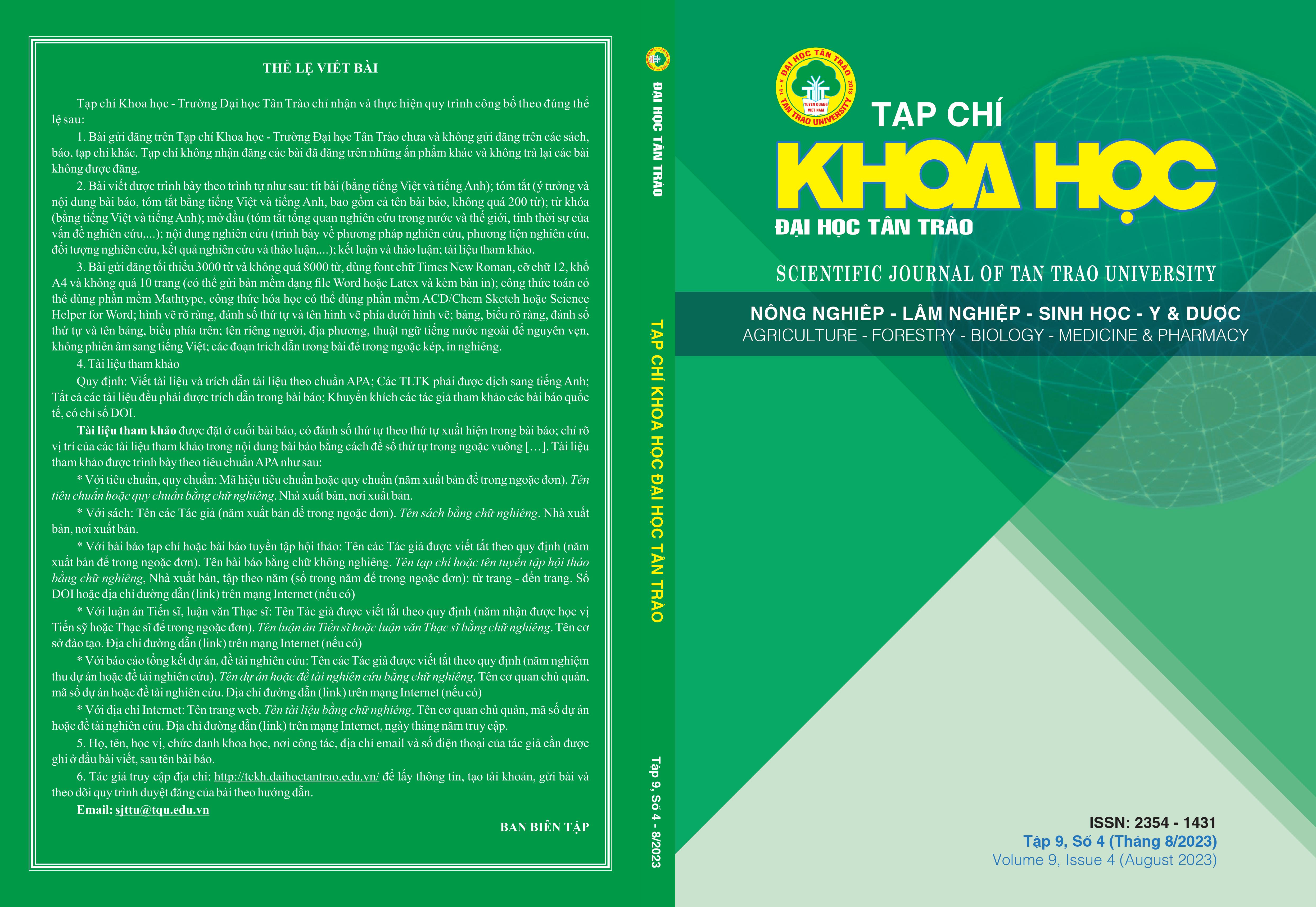STUDY ON THE PROCESSING OF TEA BAGS FROM GANODERMA LUCIDUM
DOI:
https://doi.org/10.51453/2354-1431/2023/1019Keywords:
Ganoderma lucidum Tea bag process Phu Quoc Kien giangAbstract
The mushroom is scientifically named as Ganoderma lucidum. Tea bags are popular in the world as a convenient and healthy drinking. Therefore, the research aims to build the process of producing tea bags from the fruiting bodies of Ganoderma lucidum, with a direction to greatly practical applications. The research used Ganoderma lucidum in Phu Quoc city, Kien giang province with 82% moisture, 4,2 % ash, 1.5% tannin. Ganoderma lucidum is dried at 60ºC, crushed to a size of 1 < d < 3 mm and mixed with licorice and stevia with the ratio of 20% and 10% respectively to improve the quality of the product. Analysis of the microbiological quality of the product showed that the total number of aerobic microorganisms is about 4*10⁴ colonies/g, yeast – mold is 2*103 colonies/g, Coliform is 2*102 colonies/g, Salmonella is 0 colonies /25g, meeting TCVN 7975 - 2008 about herbal tea filter bags. The results of the study are an important scientific basis, contributing to the application to improve the value of Ganoderma lucidum reishi in practical production
Downloads
References
[1] L. T. Do, Vietnamese medicinal plants and herbs. Medicine Publishing House, Hanoi, 2005.
[2] T. X. Le, Precious medicinal herbs in Vietnam. Ca Mau Nose Department Publishing House, 1996.
[3] H. Tran, Research Methods of Medicinal Plants. University of Medicine and Pharmacy, Ho Chi Minh City, 2004.
[4] S. C. Jong and J. M. Birmingham, “Medicinal benefits of the mushroom Ganoderma,” Advances in Applied Microbiology, vol. 37, pp. 101-34, 1992.
[5] N. S. Doan, “Study on the protective effect of Ganoderma lucidum on the testicular tissue structure of white mice on the swiss line when subjected to high dose irradiation,” Hue university Journal of Science, vol. 49, pp. 95-101, 2008.
[6] J. Jiang, V. Slivova, K. Harvey, T. Valachovicova, and D. Sliva, “Ganoderma lucidum suppresses growth of breast cancer cells through the inhibition of Akt/NF-kappaB signaling,” Nutrition and Cancer, vol. 49, no. 2, pp. 209-216, 2004.
[7] T. V. T. Tran, H. T. Nguyen, P. T. Nguyen, and H. T. Le, and S. L. Le, "Surveying some pharmacological effects of triterpenoid fractions from Ganoderma lucidum grown in Thua Thien Hue," Journal of Medicinal Materials, vol. 17, no. 3, pp. 154-158, 2012.
[8] D. T. Nguyen, N. H. Le, T. V. Dao, T. Q. Pham, C. T. Trinh, H. K. T. Dinh, and B. V. Nguyen, “Research on production of tea bags (cleistolyx operculatus roxb),” TNU Journal of Science and Technology, vol. 184, no. 08, pp. 11-16, 2018.
[9] N. H. Chen, J. W. Liu, and J. J. Zhong, “Ganoderic acid T inhibits tumor invasion In vitro and in vivo through inhibition of MMP expression,” Pharmacological Reports, vol. 62, no. 1, pp. 150-63, 2010.
[10] C. V. Tran, T. T. Ta, H. S. Nguyen, S. H. Luu, L. D. Vi, C. T. Trinh, L. S. Le, T. T. Huynh, M. T. T. Pham, B. X. Ngo, and T. T. Nguyen, “Research on processing tea bag filter from Cao Bang hemp leaves,” TNU Journal of Science and Technology, vol. 225, no. 11, pp. 160-165, 2020.
[11] H. L. T. Hoang, H. N. Nguyen, C. M. Nguyen, and T. P. T. Nguyen, “Research on using Vietnamese mulberry leaves in tea bag production,” Journal of Agriculture and Rural Development, vol. 13, pp. 58-62, 2012.
[12] Berna Elya, Katrin Basah, AbdulMun’im,Wulan Yuliastuti, Anastasia Bangun, and Eva Kurnia Septiana (2011), Screening of α-Glucosidase Inhibitory Activity from Some Plants of Apocynaceae, Clusiaceae, Euphorbiaceae, and Rubiaceae, Journal of Biomedicine and Biotechnology, Volume 2012, PMID: 22187534.
[13] Boh B, Berovic M, Zhang J, Zhi-Bin L. Ganoderma lucidum and its pharmaceutically active compounds. Biotechnol Annu Rev. 2007; số 13 trang 265–301. PMID: 17875480.
[14] Borchers A. T, Krishnamurthy A, Keen C. L, Meyers F. J, Gershwin M. E. (2008), The immunobiology of mushrooms. Exp Biol Med.
[15] Chan Kam Seng, Noorlidah Abdullah& Norhaniza Aminudin, 2017, “Antioxidative and Inhibitory Effects of the Fruiting Body of Black Lingzhi Mushroom, Amauroderma rugosum (Agaricomycetes), on LDL Oxidation and HMG-CoA Reductase Activity”, International Journal of Medicinal Mushrooms, 19(9):797–807.
[16] Chang S. T, Buswell J. A.(2008) Safety, quality control and regulational aspects relating to mushroom nutriceuticals, Proc. 6th Intl. Conf. Mushroom Biology and Mushroom
Downloads
Published
How to Cite
Issue
Section
License

This work is licensed under a Creative Commons Attribution-ShareAlike 4.0 International License.
All articles published in SJTTU are licensed under a Creative Commons Attribution-ShareAlike 4.0 International (CC BY-SA) license. This means anyone is free to copy, transform, or redistribute articles for any lawful purpose in any medium, provided they give appropriate attribution to the original author(s) and SJTTU, link to the license, indicate if changes were made, and redistribute any derivative work under the same license.
Copyright on articles is retained by the respective author(s), without restrictions. A non-exclusive license is granted to SJTTU to publish the article and identify itself as its original publisher, along with the commercial right to include the article in a hardcopy issue for sale to libraries and individuals.
Although the conditions of the CC BY-SA license don't apply to authors (as the copyright holder of your article, you have no restrictions on your rights), by submitting to SJTTU, authors recognize the rights of readers, and must grant any third party the right to use their article to the extent provided by the license.


